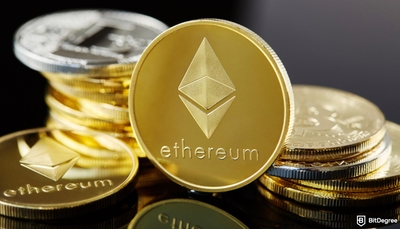Key Takeaways
- Kraken fiat and crypto deposits are usually free, with a few exceptions depending on the payment method or the crypto asset in question;
- Kraken withdrawal fees for fiat usually range from free to 35 worth of the fiat currency in question, while crypto withdrawal fees all depend on the crypto asset you want to withdraw;
- Kraken trading fees are usually based on the maker / taker fee structure and differ depending on the trading method. Spot fees for makers go from 0.25% to 0%, while for takers – from 0.4% to 0.1%. Futures fees for makers go from 0.02% to 0%, while taker fees range from 0.05% to 0.01%.
Stop overpaying - start transferring money with Ogvio. Sign up, invite friends & grab Rewards now! 🎁
There’s a fundamental truth in the financial world: revenue is always accompanied by fees, and crypto trading is no exception. It’s important to be aware of what your chosen platform can offer. Hence, in this article, I’ll take a closer look at Kraken or, more specifically, Kraken fees.
If you're comparing exchange costs, also think about what happens after you buy - Ogvio is worth a look if you want crypto storage plus fee-free crypto transfers (to, within, and from the platform).
From Kraken trading fees to withdrawal and deposit fees, I'll look over all of them. On top of that, I'll do a comparison of Kraken's fees with other popular exchange fees, namely Coinbase and Binance.
Just keep in mind that fees tend to change, but you can always find the most up-to-date Kraken fee schedule on their official website.

Did you know?
Subscribe - We publish new crypto explainer videos every week!
What Are Crypto Quests? EASIEST Ways to Earn Rewards Explained


Table of Contents
Kraken Fees
I'll be covering Kraken fees because it is one of the most popular crypto exchanges that offers a variety of services to crypto enthusiasts all around the world, including the US. Launched in 2011, Kraken has established itself as a trusted platform for buying, selling, and trading various cryptocurrencies. In fact, as of May 2024, there haven’t been any major hacking events related to Kraken.
Latest Deal Active Right Now:With a user-friendly interface and a focus on compliance and regulatory standards, Kraken caters to both novice traders and experienced investors. The exchange offers a wide array of trading pairs, including fiat-to-crypto and crypto-to-crypto options, along with features such as margin trading and staking.
Additionally, Kraken provides various account types to suit the needs of different users. There is even the regular Kraken platform and Kraken Pro, catering to different skill levels. In this Kraken fees overview, I will examine the fee structure for all of its features.
Just note that before engaging in any activities on Kraken, you must pass KYC. This includes providing some personal information, your ID, and even proof of address. That said, let's get to Kraken fees.
Kraken Deposit and Instant Buy Fees
Kraken fees for deposits depend on the asset in question, as well as the depositing method. For starters, though, note that if you have passed Express (USA only), Intermediate or Pro verification levels, you can use the Instant Buy feature to instantly purchase crypto using a credit / debit card instead of depositing fiat into your account and then buying crypto with it.
Credit card fees are impacted by the size and the nature of the transaction, and it will be clearly displayed during the transaction operation. Each credit card transaction has a minimum purchase amount, and there’s a spending limit that is reset every 7 days. The limits depend on the currency you’re using and don’t have a direct impact on your Kraken fees.

For example, if you’re using USD for your transactions, the minimum amount you should spend using a credit card is $10. Over seven days, you shouldn’t climb over $5,000 in purchases.
Now, if purchasing crypto straight up is not for you, and you prefer to add funds to your account, you can deposit fiat into your account (USD, EUR, CAD, AUD, GBP, CHF, and JPY are supported as of writing). Much like with credit cards, this option is impacted by your location.
For deposits from a US account, for instance, you will be presented with a selection of services, each slightly differing due to the deposit limit or the processing time. There are types of deposits that will allow you to deposit $1 with a waiting time of up to 1 day, but there are also options that will take up to 5 business days with a minimum operation of $150.
Fiat deposits are usually free, but there are some payment methods for which Kraken charges a deposit fee:
- SWIFT (Bank Frick) deposits impose fees – $3 for USD, €3 for EUR, $3 for CAD, £3 for GBP, and £0.75 for CHF;
- In-person cash or debit CAD deposits via Canada Post impose a $1.25 + 0.25% fee;
- Interac e-Transfer CAD transfers impose a 0.5% fee;
- Real Time Gross Settlement (RTGS) AUD deposits impose a $33 fee;
- Gibraltar CHAPS (ClearJunction) GBP deposits impose a £21 fee.
Deposits can also be done with crypto assets. Most crypto deposits don't impose any Kraken fees. Only Terra Classic and TerraUSD Classic deposits have a 0.5% tax burn as a fee. There’s also the minimum deposit requirement for the assets.

If the amount of crypto you want to deposit is too low to meet the threshold set by the platform, Kraken has a system that allows certain assets to stack, so you can reach the minimum requirement over several deposits. As of writing, stackable deposits on Kraken include ETH, ETC, AVAX, ETHW, EWT, SGB, FLR and all ERC-20 tokens.
Unfortunately, if your preferred crypto falls into the opposite category, you will have to meet the criteria for minimum deposit, or your crypto will not be credited to the account despite being sent.
Now, with deposits and the Instant Buy fees covered, let’s move on to Kraken withdrawal fees.
Kraken Withdrawal Fees
Trading fees are only one part of the cost. If you're moving funds between people often, using a wallet that supports fee-free transfers can reduce friction. For this, I would highly recommend exploring Ogvio.
Fiat withdrawals cannot be done using credit or debit cards, third-party apps or cash; the platform only supports it through bank transfers. Do note that fiat withdrawals have a minimum withdrawal limit, which depends on the asset in question and the chosen withdrawal method. Kraken withdrawal fees for fiat also depend on the latter:
Minimum withdrawal range | Withdrawal fees range | |
|---|---|---|
USD | From $1 to $150 | From $0 to $35 |
EUR | From €1 to €150 | From €0 to €35 |
GBP | From £1 to £150 | From £0 to £35 |
CAD | From $15 to $1,000 | From 0$ to $35 (or 35% of the withdrawal amount) |
CHF | From CHF 2 to CHF 150 | From CHF 1 to CHF 35 |
AUD | From $5 to $150 | From $0 to $55 |
JPY | From ¥15,000 | $35 equivalent in JPY |
Table: Kraken withdrawal fees for fiat
What’s more, there are Kraken withdrawal fees for crypto. Crypto withdrawals also have minimum amounts you can withdraw and crypo-based withdrawal fees. For example, the minimum withdrawal amount for Bitcoin is 0.0004 BTC, while the withdrawal fee is 0.0002 BTC.
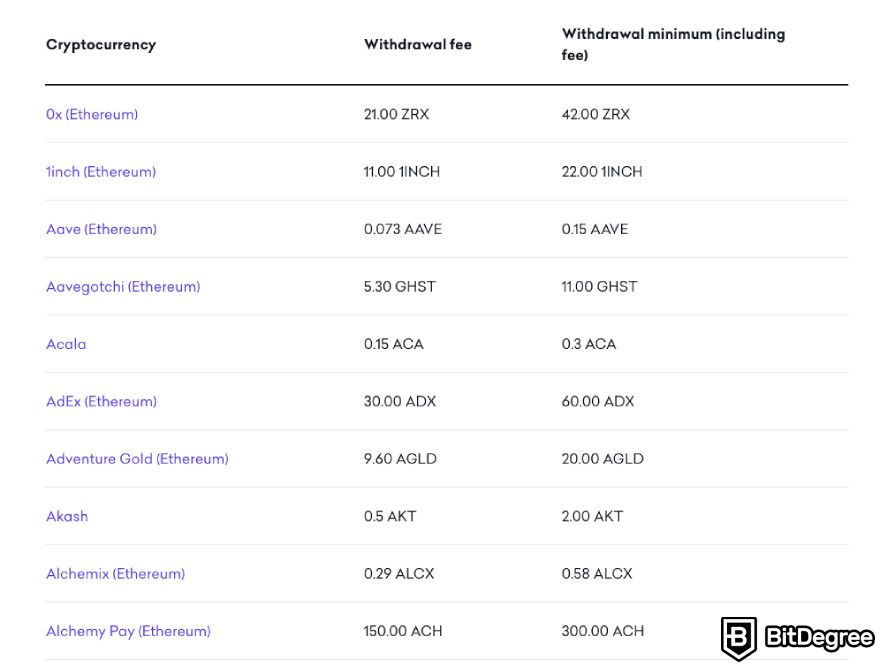
The availability of crypto you can withdraw is impacted by the region you’re in. Crypto withdrawal fees are not based on cost percentage but follow the same set-price rule that bank withdrawals have.
As a side note, keep in mind that some of the first-time deposits on the platform will trigger a 72-hour lock on withdrawals, meaning you will only be able to withdraw your fund during that period.
Kraken Trading Fees
Like most exchanges, Kraken charges fees according to the executed trades. Overall, the fees depend on several factors, including the crypto pair that’s being traded, the 30-day personal trading volume, and whether you’re classified as a market maker or taker.
Maker orders add liquidity and, for this reason, tend to have lower charges compared to taker fees. Alternatively, taker fees are applied when the order is instantly fulfilled, which affects liquidity in a negative way.
That said, there’s a way to lower the maker and taker fees, sometimes even all the way to 0%. You can do that by increasing your personal 30-day trading volume. This feature falls under Kraken Pro.

Kraken Pro is a trading platform designed for experienced users. Unlike the regular Kraken account, this version provides advanced services like spot, margin and futures trading. Basically, any service other than direct buying and fiat or crypto deposits falls under Kraken Pro.
The advanced platform benefits greatly from the Kraken fee schedule, especially if you trade in high volumes on a regular basis. In fact, crypto-based fee schedules can potentially lead to optimal trade execution[1], which is beneficial to users.
Keep in mind that while trading volumes determine the distribution of Kraken fees, each type of trading calculates its own volume, and they are not pooled together. This means that if you perform well in spot trading, the discounted fees will only be applied there and won’t be transferred to futures.
Spot Trading Fees
Speaking of spot trading, Kraken Pro fees for makers go from 0.25% (with $0 - $10,000 trading volume) to as low as 0% (with $10,000,000+ trading volume). Taker fees, on the other hand, go from 0.40% (with $0 - $10,000 trading volume) to 0.1% (with $10,000,000+ trading volume).
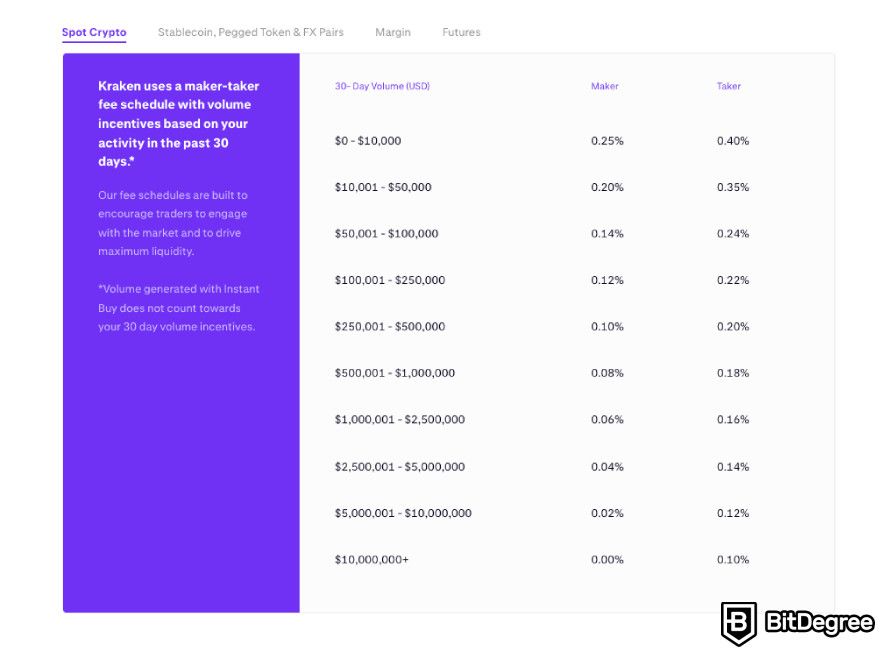
Futures Trading Fees
Now, the Kraken fee schedule for futures trading is a bit different. Maker fees go from 0.02% to 0%, while taker fees go from 0.05% to 0.01%.

Margin Trading Fees
Moving further, if you engage in margin trading, there will be opening fees and a rollover fees (the latter paid every 4 hours). The fees depend on the asset in question, but there are no discounts on them, regardless of your trading volume.
The opening and rollover fees match, and they usually are 0.02%. However, the Bitcoin opening and rollover fee is 0.1%, while the US Dollar opening and rollover fee is 0.025%.
Stablecoin, Pegged Token, and FX Pair Fees
Lastly, there’s a specific Kraken fee schedule for FX pairs (e.g., EUR/USD), stablecoins with base currency (like DAI/USDT), and pegged tokens (such as TBTC/BTC). Do note that these fees can be reduced by increasing the trading volume, but the volume-based tiers are different than those of Kraken Pro fees for spot and futures trading.
For makers, the fees start at 0.2% (with $0 - $50,000 trading volume) and end at 0% (with $100,000,000+ trading volume). Meanwhile, taker fees start at 0.2% as well, but end at 0.001%.
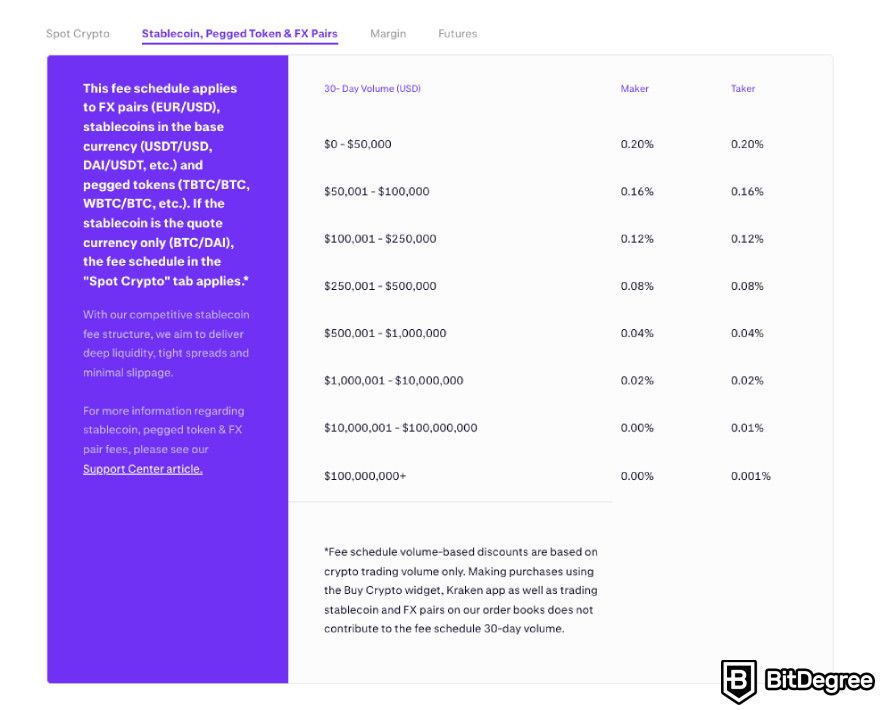
Do note that the tier system for Kraken Pro fees is re-evaluated every 30 days, so you have to keep up with the trading or you'll lose your bonuses, which can get strenuous in the ever-fluctuating market.

- Secure and reliable
- Accepts fiat currencies
- Lots of trading options
- Reputable exchange
- Accepts fiat currencies
- Offers various trading options

- Huge trading variety
- Regulation-compliant around the globe
- Fair trading fees
- Beginner-friendly
- A wide array of features
- Vast number of different crypto coins & tokens

- Beginner-friendly
- Secure
- Decent trading and withdrawal fees
- Crypto.com Visa Card
- Automated tools & bots
- Ecosystem synergy with CRO
Other Kraken Fees
It’s worth noting that it costs absolutely nothing to open a Kraken account and use all the available features. Most of the fees on the platform are related to crypto trading, but I have to mention that you can also trade NFTs on Kraken.
Of course, NFT trading has its own set of fees, and the transaction costs vary according to network conditions. For NFTs, Kraken takes a 2% transaction fee.
Kraken withdrawal fees for NFT also have supplementary set charges: Ethereum withdrawals require 0.01 ETH, Solana withdrawals cost 0.02 SOL, and Polygon-based transactions require 0.5 MATIC. That said, it costs nothing to deposit or list the NFT.
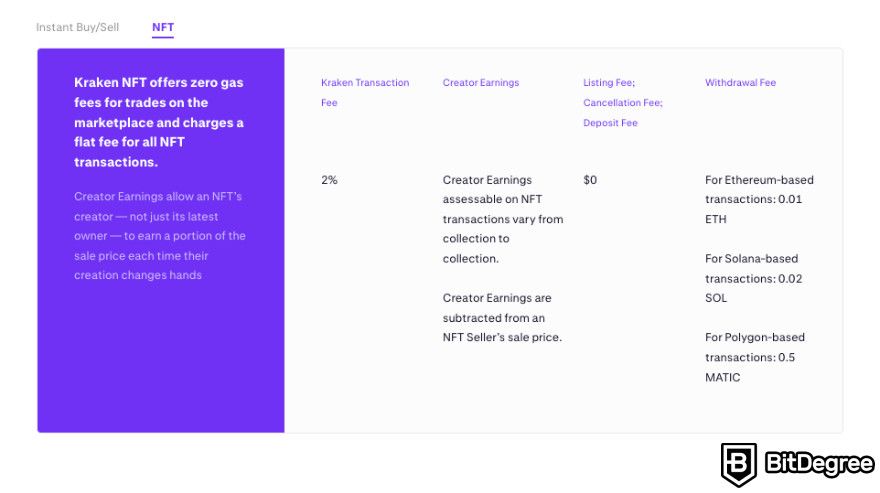
Speaking of NFTs, there are also Creator Earnings, which are set by the NFT creators themselves.
Now, keeping the Kraken fee schedule in mind, note that the platform has Kraken fee credits (KFEE), which can be used for fees. 1,000 KFEE equals $10, and if you have enough tokens on your account, it will automatically be used to cover your trading fees.
However, you can’t use KFEE for deposits or withdrawal fees, nor in futures trading. How to get them? The credits are simply occasionally offered to users at irregular intervals. By the way, they have no expiration date.
Kraken Fees VS Coinbase Fees
Since I've talked so much about Kraken trading fees, it’s natural to get curious about how it all holds up against other big players in the industry. After all, even minute differences in the costs can add up to quite a fortune.
In this particular case, I’ll take a closer look at fees on Coinbase and how specific aspects, such as Kraken withdrawal fees, measure up against equivalents on the rival exchange.
One of the major differences is the maker and taker fees. As previously mentioned, Kraken maker taker fees follow the tiered system of the fee schedule, and Coinbase has a similar bracketed system. However, the costs differ greatly.
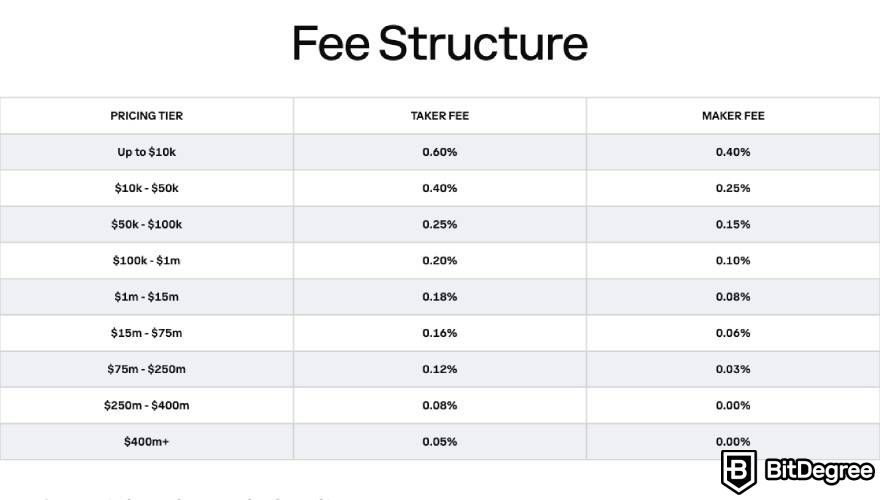
Let’s examine the first tier on both exchanges. Kraken marks the first level on their platform, going up to $50,000, whereas Coinbase’s first tier is up to $10,000 (with $50,000 being the ceiling for the second level).
On Kraken, the spot maker fees for the first tier are 0.25%, while the spot taker has to cover 0.4%. Coinbase marks the maker fee for the first bracket as 0.4% and the taker fee as 0.6%. The jump between the two is quite noticable.
Just note that Coinbase doesn’t categorize different forms of trading, applying the same fee and tier system to both spot and futures trading. That contradicts Kraken’s fee schedule, where fees are set according to different trading categories.
Another difference is the stablecoin pair trading. On Kraken, there’s a whole fee schedule designed around the volume of this particular trade. On the other hand, on Coinbase, there are no fees for makers trading in stablecoin pairs. Though, there are taker fees and they do have different tiers, which are based on takers' liquidity program tier – the fees go from 0.1% to 0.3%.

Next up are the deposit and withdrawal fees. Bank transfers are preferred by both exchanges, but where Kraken has more options to pick from, Coinbase embraces simplicity with a lesser bank selection.
Deposits via a bank can be done for free on both platforms, but Kraken gives this option to both US and European banking methods. Coinbase supports free deposits from ACH only; other deposits, even within the US, will have a fee.
Coinbase’s withdrawals are also free when using ACH, but users are charged a set fee for using other methods. Kraken, as we discussed above, has a wider selection for users to pick from, which makes Kraken’s deposit / withdrawal system a bit more flexible.
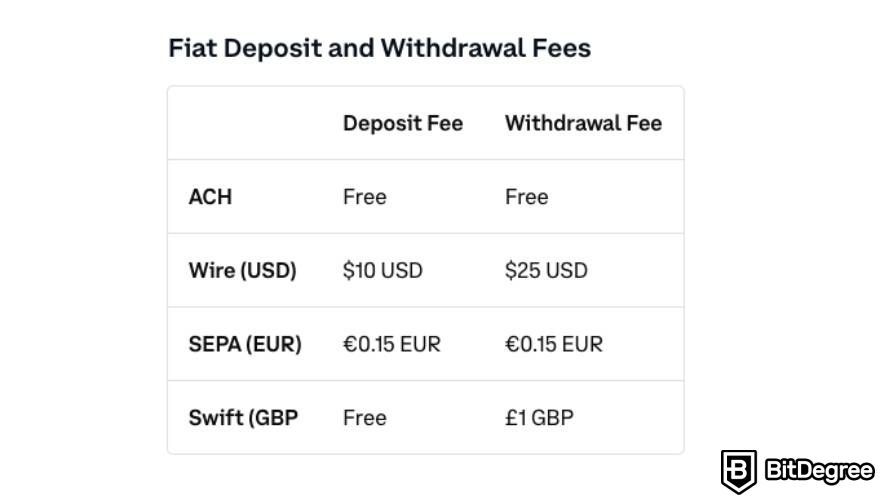
While on the topic of Kraken fees vs Coinbase fees, I have to point out the common ground for both exchanges. The volume is calculated in 30-day intervals, which requires constant upkeep of trading operations. Both exchanges also have fees for transactions on a crypto network, which fluctuate according to the state of the network.
Lastly, it’s worth noting that Coinbase has a program called Coinbase One that promises zero trading fees. It’s a subscription with additional services attached to it, but from the perspective of fees, it costs approximately $30 per month, so users need to evaluate if their fees exceed this cost.
Kraken Fees VS Binance Fees
If you’re wondering how Kraken fees would hold up against another popular exchange, Binance, I’m here to shed some light on it. In general, Binance also uses the tiered fee structure, but it is much steeper. While the trading volume is calculated every 30 days, something that’s seen as standard in the industry, Binance's first VIP tier requires more than $1,000,000 worth of monthly trades.
The VIP levels automatically set the fees for various trading options, but let’s take spot trading as an example: if your trade volume is less than $1,000,000, you’re considered a regular user, and you’ll pay 0.1% for both maker and taker fees (which is a great deal nonetheless).
Should you reach VIP 2, with more than $5,000,000 worth of trades, your fees will be 0.08% if you're a maker and 0.1% if you're a taker. These fees can then be further lowered by using BNB to cover up to 25% of the trading costs.
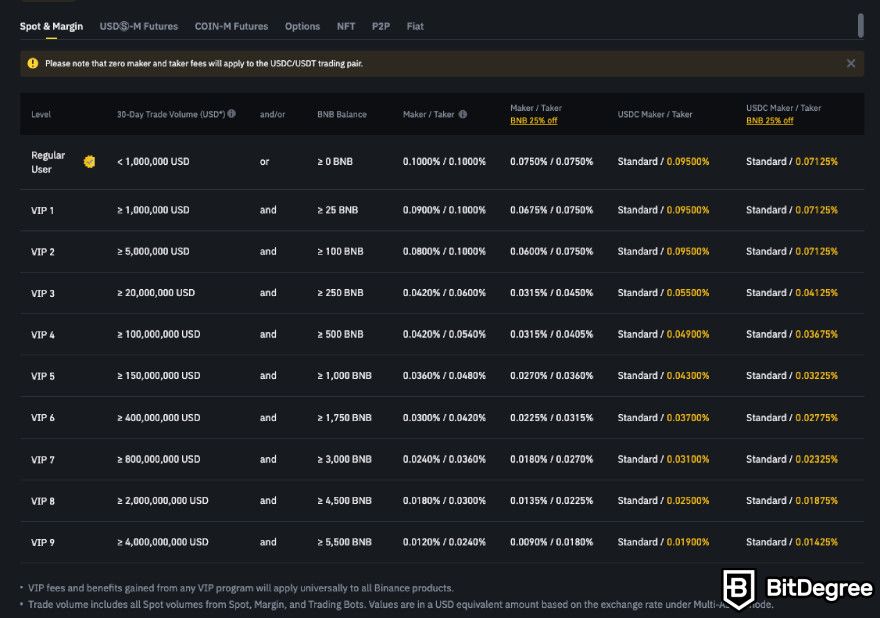
This creates an interesting trading conundrum when compared to Kraken fees. At its lowest tier (comparable to the Regular level on Binance), the maker and taker fees on Kraken are 0.25% and 0.4%, respectively.
It’s comparatively higher than the 0.1% that Binance offers. However, Binance’s fee will be the same until you hit the threshold for the next tier, which is marked in millions, whereas Kraken offers more beneficial fees for makers from $500,000, charging the maker 0.08% instead of 0.1% for the same trading volume on Binance.
It’s advisable to determine your trading volume upfront since even the smallest shifts down the line can translate into quite a sum. If you’re doing spot trading in lower volumes, Binance might be a better pick because it offers better fees from the get-go.
However, Kraken offers tiers that are influenced by smaller sums than on Binance, which allows users to reach new levels and fees quicker.
On Binance, the fee for depositing crypto is always 0%, but the withdrawal fees depend on the asset itself since the tokens have different withdrawal costs attached to them. Fees regarding deposits and withdrawals in fiat also fluctuate based on the payment method you want to use.
This seems to match up with what Kraken is offering as well, with a free deposit of crypto into the account wallet and fees that shift according to payment methods.
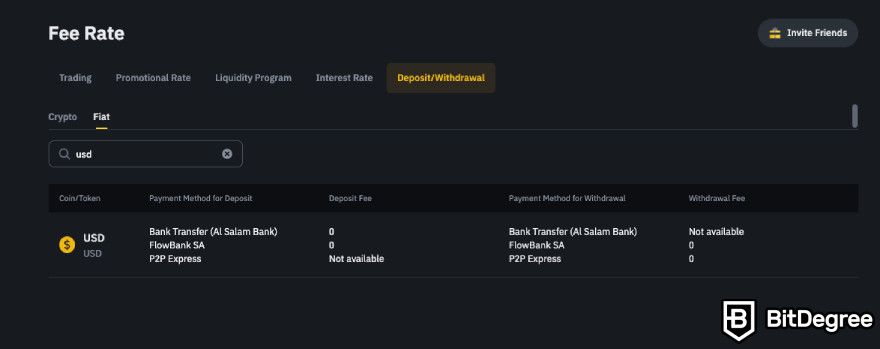
Taking USD as an example, Binance offers two payment options featuring this fiat. While both are free, Kraken users have way more USD deposit and withdrawal options to pick from.
Alternatively, EUR deposits and withdrawals on Binance have a list of options ranging from credit cards to third-party options, all coming with their own fees (some even free), which seems to be a better selection than what's provided by Kraken (mostly bank transfers).
Lastly, let’s take a look at NFT fees on the two exchanges. Kraken fees related to NFTs are a 2% transaction charge and a set withdrawal cost that depends on the token type; deposits and cancellations are free.
Binance, on the other hand, has a flat 1% platform service fee when you sell NFT from third-party platforms, and withdrawal fees are charged according to the market conditions, so they fluctuate.
All in all, it seems that both Binance and Kraken have their pros and cons when it comes to fees, so the choice of which one is a better option depends on your needs.
Why Are There Fees at All?
With all this talk about Kraken trading fees, you might wonder why there are even fees in the first place. After all, one of the tenets of crypto is financial freedom. Well, as the cliche goes, freedom comes at a price, or, in this case, fees.
The main reason crypto exchanges have charges attached to their transactions is to keep the exchange going. The fees provide funds to support existing services or even expand the selection of available utilities.
Transaction fees also help out validators who watch over and legitimize the transactions. This means the costs you pay don't only settle in the pockets of the exchange; they are also used to incentivize the people who keep the blockchains functional. In facts, without transactional costs, a blockchain becomes not viable[2].

Additionally, fees can not only support the exchange’s infrastructure but also be a sign of a healthy platform. Usually, that’s facilitated by maker and taker fees. In essence, as you already know, makers increase the liquidity of the exchange, so their fees are often lower than taker fees. A proper balance between the two (without one being too low or too high) could mean robust economic standing.
Speaking of a healthy environment, fees can be a point of contention between exchanges, but they also provide users with opportunities. Different fees breed competition, and that can only benefit traders, as they can utilize the changes in costs to preserve or get the most out of their assets.
Of course, there are also fees that are out of the exchange’s control. For one, there are the aforementioned transaction fees (also known as network fees). Moreover, withdrawals and deposit fees are often charged by third parties. In this case, such fees shouldn’t be considered as part of the platform.
Conclusions
To sum everything up, Kraken fees follow a specific tiered structure that lowers the fees when increasing monthly trading volume. However, the Kraken fee schedule supports separate volume capacities for different forms of trading. Kraken Pro fees are automatically applied to various advanced trading methods, so users don’t have to indicate them manually.
Most exchanges seem to follow the same general rule as the Kraken maker-taker fees, with a tiered system available on both Coinbase and Binance, with the difference in the trading volume bracket size and the fees themselves.
So far, based on Kraken fees vs Coinbase vs Binance costs comparison, Coinbase has the lowest entry towards the pricing tiers (with $10,000 needed to reach the second level), while Binance seems to have the lowest initial fee (0.1% for makers and takers). Kraken stands in the golden middle.
The system that supports Kraken trading fees offers flexibility to both new and advanced users, and while it may fall short compared to specific aspects of other exchanges, it remains a solid choice for people who want to take advantage of the tiered fee system.
If you're optimizing your total costs (not just maker/taker), pairing your exchange with a wallet like Ogvio can make transfers feel enjoyable, due to zero fees, instant speed, and the ability to withdraw your crypto straight to your bank account without worrying about conversions.
Not investment advice. Crypto trading involves risk of loss and is offered to US customers through Payward Interactive, Inc. View legal disclosures at kraken.com/legal/disclosures.
The content published on this website is not aimed to give any kind of financial, investment, trading, or any other form of advice. BitDegree.org does not endorse or suggest you to buy, sell or hold any kind of cryptocurrency. Before making financial investment decisions, do consult your financial advisor.
Scientific References
1. N. Bundi, C. Wei, K. Khashanah: 'Optimal Trade Execution in Cryptocurrency Markets';
2. D. Easley, M. O'Hara, S. Basu: 'From Mining to Markets: The Evolution of Bitcoin Transaction Fees'.






